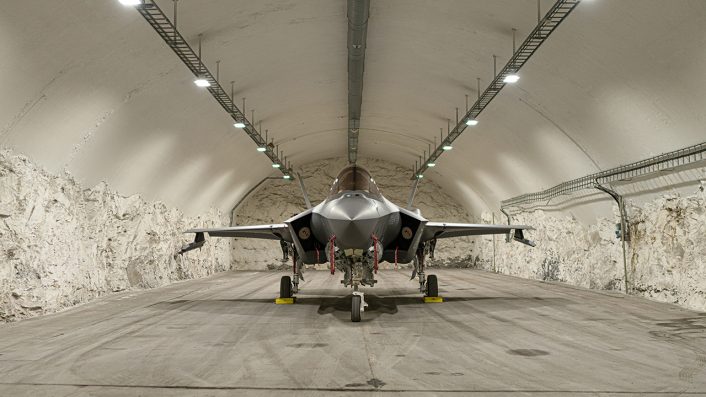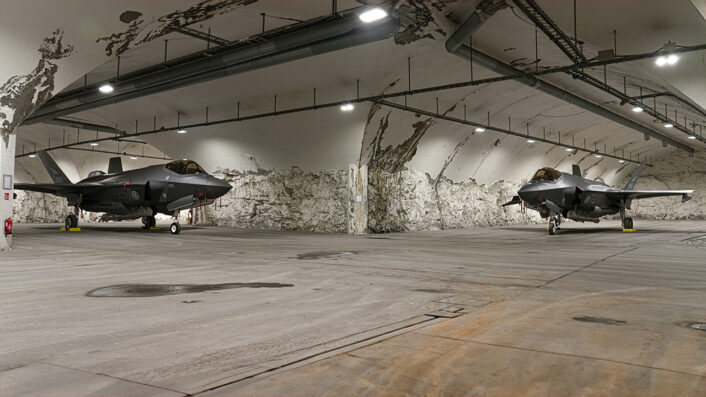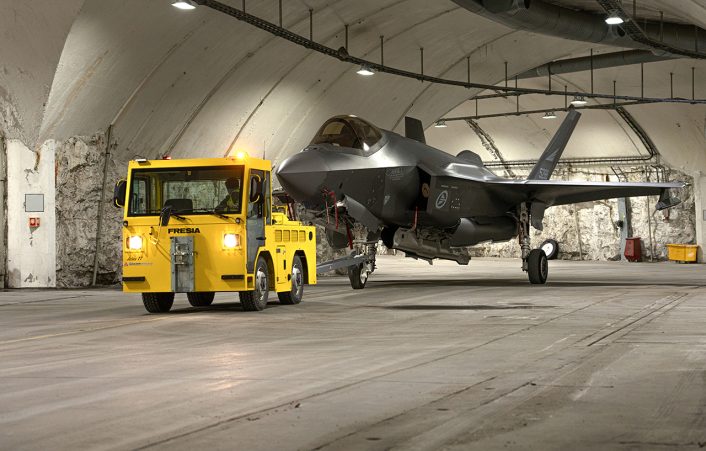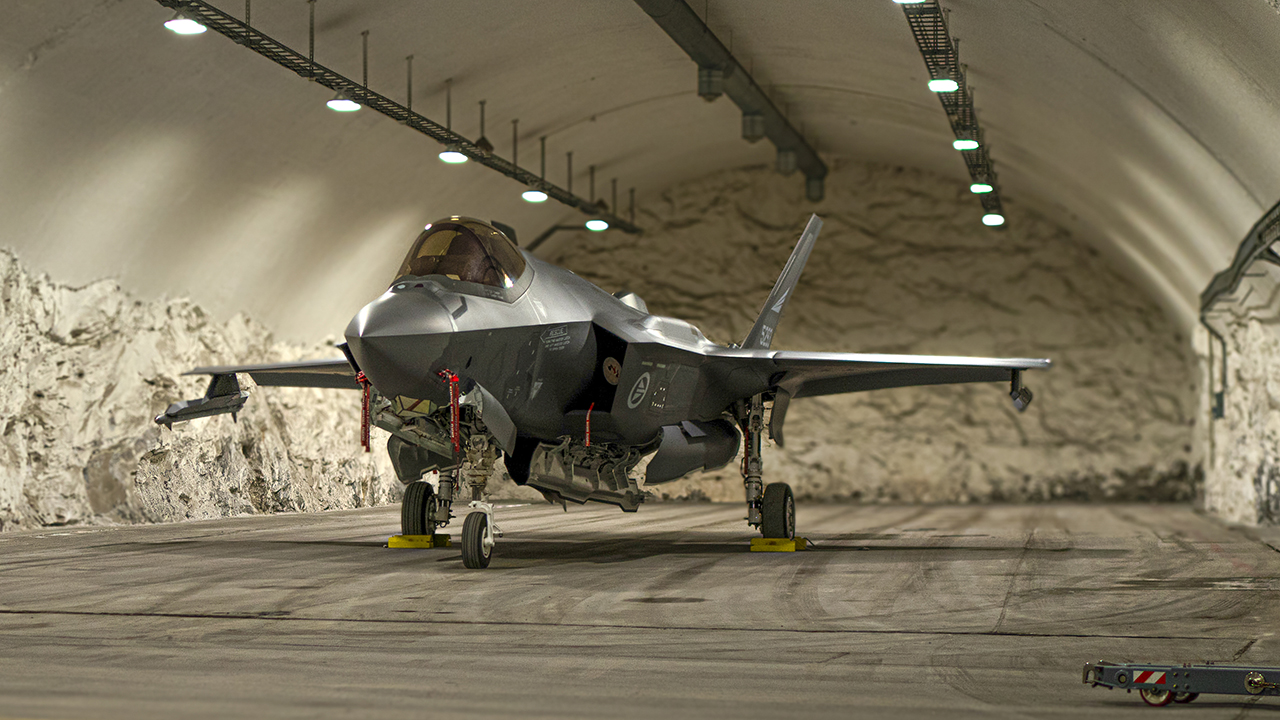The conflict in Ukraine has shown that even the most advanced aircraft are at risk when on the ground, thus, strategic dispersion and robust protective measures are necessary to maintain operational readiness in hostile environments. For this reason, the Royal Norwegian Air Force used the mountain hangar for the first time in 40 years.
The ongoing conflict in Ukraine has starkly illustrated the vulnerability of aircraft to kamikaze drone attacks when they are sitting on the apron and not recovered inside a hardened shelter. We have recently reported about the Russian Su-57 Felon jet targeted by Ukrainian UAVs at Akhtubinsk airfield in Astrakhan Oblast, some 600 kilometers from the border.
In the last few days, footage has also emerged of the destruction of a Ukrainian Su-25 Frogfoot at the Dolgintsevo airfield in the Dnepropetrovsk region with Lancet loitering ammunition.
A Ukrainian SU-25 Attack Aircraft stationed at Dolgintsevo Airbase near Kryvyi Rih was destroyed by a Russian ZALA Lancet Loitering Munition, which caused a fuel fire after impact.
It also seems that there is a Radar/Air Defence Position near it.
📍47.9030514, 33.5262719 pic.twitter.com/oZKYF0nPl0
— WarVehicleTracker (@WarVehicle) June 11, 2024
Previously, on Feb. 26, 2023, Ukraine-affiliated Belarusian partisan group BYPOL, damaged an A-50U AWACS (Airborne Warning and Control System) by landing a kamikaze quadcopter on its radar disc at Machulishchy air base in Belarus.
While different measures have been put in place or tested throughout the war by both sides to protect their assets from the air strikes (including some creative ones, like the use of rubber “tires” on the wings of large bombers; anti-drone structures and light hangars), the most effective way to mitigate the risk is to disperse aircraft across multiple locations and to have the combat aircraft recovered inside hardened shelters scattered across the airbase. By doing so, the likelihood of any single attack causing significant damage to one or more aircraft is reduced, ensuring that a nation’s air capabilities remain intact even under sustained assault.
Furthermore, the ability to recover and house aircraft in underground bunkers and mountain hangars, adds an additional layer of protection. These shelters can withstand attacks that would devastate more conventional structures, preserving valuable military assets.
The F-35As at Bardufoss
Aware of the importance of both dispersal and hardened shelters in current and future scenarios, the Royal Norwegian Air Force has recently “dusted off” the mountain hangar at Bardufoss Air Station, in northern Norway.

The air station plays a crucial role for the Norwegian, Nordic, and allied air power. The capability to disperse and quickly move air forces is a major focus in NATO, emphasized through the development of the Agile Combat Employment (ACE) concept.
ACE is the newest strategy adopted by NATO to enhance the resilience and survivability of allied air operations. This concept integrates existing air stations with temporary operational bases to distribute resources and generate combat air power effectively.
Based on the images released by the Forsvaret, at least two RNoAF F-35A aircraft were deployed there and made use of the hangar to validate the operational concept.
“Test of dispersal concept for F-35”
Royal Norwegian Air Force F-35s in the underground/mountain complex at Bardufoss Air Base.
Photo: Martin Mellquist / Forsvaret pic.twitter.com/DBAOHjLJTS
— Thord Are Iversen (@The_Lookout_N) June 13, 2024
According to the Norwegian Armed Forces, the mountain hangar at the base has received enhancements and has been better equipped for operational use and, in the long term, this may lead to increased national and allied fighter aircraft activity.
The deteriorating security situation and the war in Ukraine highlight the necessity for the Air Force to enhance its capabilities, the Norwegian military highlights. “Stealth fighters, despite their advanced technology, are vulnerable when stationed on the ground. Both Evenes and Ørland airbases are protected by air defenses, a capacity that is slated for significant reinforcement according to the adopted long-term plan. Additionally, the Air Force must be prepared to disperse combat aircraft across various airports and air stations throughout Norway and the Nordic countries during crises and wartime.”

“This necessitates the utilization of suitable mountain facilities for protection. As part of the development of our national distribution concept, we are maximizing the use of the entire air station at Bardufoss. Primarily, this initiative is about maintaining readiness. In the long term, it could also lead to increased national and allied activity,” said Brigadier Tron Strand, head of the Joint Air Operations Center (JAOC).
As a result, investments in facilities like those at Bardufoss are not just about current operational needs but are also a crucial part of long-term strategic planning. These measures ensure that air forces can continue to operate effectively even in the face of modern threats, highlighting the importance of both dispersal and hardened shelters in contemporary military strategy.

Highway Operations
Interestingly, the RNoAF have also started training in highway operations last year, to increase their ability to operate from unimproved runways at dispersed locations. Two F-35As of the RNoAF operated out of a road strip in Finland for the first time on Sept. 21, 2023, as part of Baana23 dispersed operations exercise during which the two Lightning II aircraft landed on a road near Tervo, in the province of Eastern Finland.
As we reported back then, the landing on the Finnish motorway by the RNoAF F-35As marked the first time a CTOL (Conventional Take Off and Landing) variant of the Lightning II carried out highway operations.
The Norwegian F-35s that took part in Baana23 and those that carried out the activity at Bardufoss were all equipped with the distinguishing special fairing on the upper rear fuselage between the vertical tail, that houses the aircraft’s drag chute. For operations in the Arctic environment, A models can be equipped with a drag chute that can be used to rapidly decelerate after landing on icy runways under windy conditions. Currently, only Norwegian F-35s are equipped with the drag chute pod.













